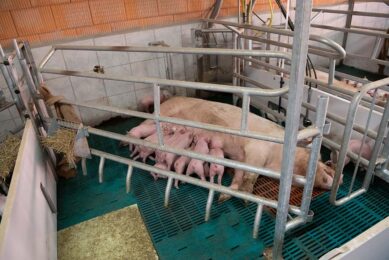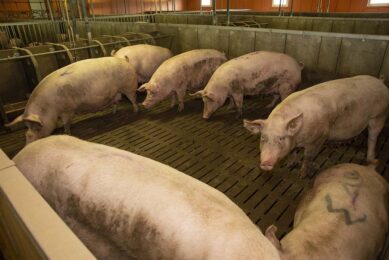What the textbooks don’t tell you about… Savaging

There is no pig textbook, save one, from the 30 or so on my shelves which even mentions savaging – an alarming and annoying occurrence –, let alone what to do about it. That surprises me, as that great pig-specialist veterinarian, the late Mike Muirhead once told me that he thought the incidence could be as high as between 1% and 3% in replacement gilts, so it must be relatively common. I have no figure to give you for older sows.
By John Gadd
I first came across savaging in the 1980s. For seven years we had a breed at Deans Grove farm whose sows were noted for their milkiness and mothering qualities, even if their progeny were a bit slow-growing compared to those of several competitors. In the end we decided to try some lines from a breed whose progeny were said to be faster and leaner growers.
Black looks
We soon found these sows were rather highly-strung in comparison to the placid old things we were used to and we got some black looks from our manager Gordon, who was a very good stockman, and who found the new gilts a handful to manage and train.
From years of hardly a case of savaging, we experienced quite a lot, which got us thinking that it could be a breed difference. But other breeders who had the same breed – but not from the same source, necessarily – said they had little of this problem from their gilts.
Line within the breed
This suggested it was more of a line within the breed rather than the breed itself. Anyway we were stuck with these flighty gilts and had to do the best we could with them.
This initial experience plus those from the 30 or so call-outs I’ve been involved in since then leads me to suggest the following likely causes…
Nervous breed or line within the breed
Watch suspect lines very carefully for the first three days after farrowing. If the suggestions below don’t work then you may have to change the breed emphasis.
Harsh environment and nutritional inadequacy
I was told years ago that these could be aggravating factors in nervous sows. But surely these days with gilts being such expensive animals they are looked after well in these respects – no, I think the reasons are closer to home.
Lack of empathy
Even before the 1980s when I was helping to select thousands of replacement gilts a year for the Taymix farm and for local farmers nearby I often did my ‘clap test’ close to the ears to note degree of alarm or unconcern. Talking to our own stockpeople as well as those farmers putting forward their gilts for selection it seemed most likely that the quietest, least nervous gilts were those whose attendants had frequently moved among them/talked to them/played music as routine.
Large groups in straw yards
There is more of this these days – 100 to 150 animals together. No real pecking order exists and gilts can become apprehensive and develop what I call a ‘nervous hostility syndrome’ to their companions which could well manifest itself on their new-borns when the time comes. Not everyone is large enough to have such huge gilt pools, but the same condition could develop in smaller replacement gilt pens (the peck-order is established but confinement stress replaces it) especially if the gilts do get stressed and the stockperson is too busy to walk among them and get them used to him/her.
Wild-eyed look
Such disturbed animals develop a ‘wild-eyed’ look in late pregnancy and especially after farrowing. While pregnant they may need segregating into another yard with ample straw, dimly lit (75 lux) and frequent movement among them by their stockperson with the occasional pig nut scattered in front of individuals. This encourages empathy and reduces the feeling of strangeness/anxiety in the new entrants.
Some other things you can do
Try putting a nice quiet sow next to a potentially nervous gilt in the farrowing pen.
Get her used to confinement. A nervous gilt turns into a savager just because she objects to the sudden confinement of the farrowing crate.
The solution could be to put such a ‘wild-eye’ suspect into a gestation crate for a while (14 days) next to a placid sow in the same condition before either of them farrow.
Once a gilt savages, try rubbing the mouth area with a rag and wiping all her litter with it – but this is better done under mild sedation – see below.
What the vet can do
He can use an anti-hysteria drug on a long-term basis. Or he can show you how to use a tranquilliser like ‘Stresnil’ – using the correct dose for weight and timing it correctly so that when the gilt is sufficiently sedated her litter can be moved out of harm’s way and her mouth area smeared before she fully comes-to.
Vis-à-vis other drugs, some people have told me prostaglandins on the 113th day could help reduce savaging – but is this so? Surely these merely help to get all the gilt farrowings into working hours so that supervision is more likely and a ‘wild-eye’ more likely to be noticed and a Stresnil shot for her given? Discuss with your vet, please.











